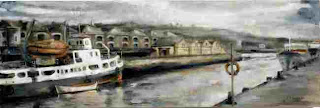Coloured Media
Most expressive media:
Wax crayon and Oil Pastel
Pros and Cons: Quickly covers large areas, expressive and bold, can be used as resist under ink and watercolour washes. Oil pastel can be used in a wash technique when diluted with thinners, easily blendable.
Cons: not conducive to fine detail
 |
| oil pastel |
Watercolour crayon
Pros and Cons: Can use as wash under or over pencil, pastel, wax crayon or pen, versatile – can use dry or wet – diluted with water, easily blendable, covers large areas quite quickly, expressive and bold, not a good choice for fine detail.
Conte Crayon
Pros and Cons: Detail possible with corners and edges, quite sturdy, slightly less messy, more controllable and less dusty and doesn’t wear down as fast as soft pastel, quite good for detail although not as good as pen or pencil.
Soft Pastel
Pros: the texture is more velvety and colours are vibrant, and more powerful than their equivalent in Conte, but the brand may have and influence on this. Lighter shades are more vibrant if combined with darker shades than when used alone. Also vibrant on tinted paper. Easy to blend.
Cons: Both Conte and soft pastel are messy – powdery and dusty and need to be fixed. A large range is needed to achieve the optimum no of colour variations.
All above crayons and pastels are more convenient than paints for sketching on location.
Best for both expressive and more detailed work:
Coloured ink on stick, feather quill and dip pen.
Fine detail is possible but can be unpredictable and more difficult to control the flow of ink than commercial pens, but when things go right the results can be more rewarding when expressive and delicate lines and marks start to emerge. Areas of tone must be built up with lines, dashes or dots of some kind, which can often be very time consuming depending on the amount of detail used. A brush can be useful to wash on smooth areas of colour and/or tone, under or over dry mediums such as soft pastel, pen etc. Ink used on a sponge or rag is effective for suggestions of rough textured surfaces such as rocks and tree bark. Being eraser proof can be a help as well as a hindrance, in that most other dry mediums when used over ink, can be erased without interfering with the ink layer. This could be desirable or not.
 |
| ink |
2. Media more suitable for detailed work.
Coloured pencils
Pros: non smudge and comparatively easy to control, clean and convenient when outdoor sketching or on the move. Fine detail is easier than with crayon or pastel, but comparatively slow to cover open areas.
 |
| coloured pencil |
 |
| fibre tip |
Felt tips
Definitive, incisive marks and lines, pure uniform colour, good for adding definition and detail. Not possible to soften or graduate areas by smudging or erasing, very uniform thickness of line, slow coverage, lighter colours tend be gaudy, unless expensive pens are used.
Gel pens
Very precise line – good for detail, scratchiness of line can look expressive depending on how it is held. Very time consuming to build up areas of tone/texture especially with dots or dashes, lines can be hit and miss and can be blotchy.
3. Most enjoyable
Watercolour pencils and crayon - shading with tip moistened in water giving a deep rich impasto effect and vigourous lines by rubbing side of tip.
Wash on hatched areas producing smudgy texture where lines remain visible.
Applying washes using watercolour crayons or oil pastel hardens the outlines and intensifies colours,
Dry shading applied on dried wash – good for intensifying narrow delicate lines as on a cabbage.
Oil pastel and watercolour crayon and pencil blending - harmonious colours, then applying twisted dots or flecks of much lighter or darker shades or colours over top builds up a very textured look
Pushing side lengthways in opposite directions in random fashion – many possible uses including foliage, rocks, bark, flowers, seed heads, shells and cones - (all on oil pastel on A2).
Producing muted colour combinations by blending certain bright colours such as lime green and yellow orange.
Scraffito
Wax resist
Soft pastel and conte crayon - building up webs of colour by hatching in random broad strokes - optical blending (as Degas). Blending (shading), then loose hatching over top (also coloured pencils). Long wavy lines using harmonious colours.
Soft pastel – very vibrant colours especially when very light and very dark hues (not blended) are combined.
Flat end of stick rotated producing broken lines.
A useful tip I discovered: If I apply a wash over fibre tip pen, colour cannot be trusted not to bleed (although this can be attractive at times), but if dry pencil or watercolour crayon, in same hue as wash, is rubbed on line first, the line doesn’t appear to smudge.



















